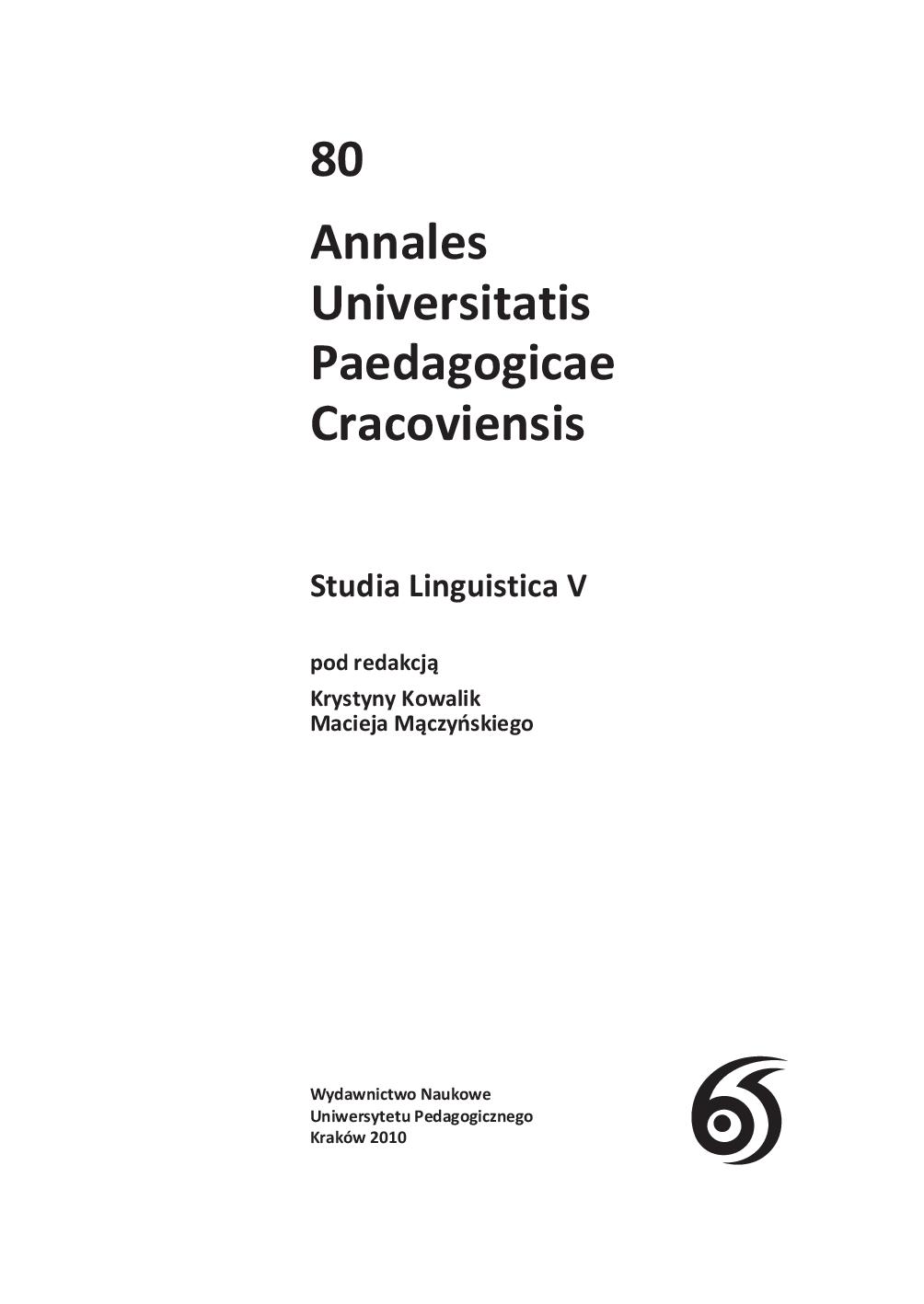Język młodych tarnowian w świetle korespondencji elektronicznej
Main Article Content
Abstract
inhabitants of Tarnów. The research corpus consists of about 200 e-mails written by pupils
of Tarnów schools between March 2007 and April 2008. Main emphasis of the research
is put on the novel linguistic forms which determine the innovative character of e-mail
communication, in particular: technical and technological vocabulary, abbreviations and
acronyms, borrowings, graphic signs and specific spelling forms, and vulgarity of expression.
Those observations do not characterize the whole lexicon, but only a selected fragment of
the linguistic reality, yet on this basis we may claim that the internet language of the youth is
strongly influential and growing in range, and should become a subject of a detailed linguistic
analysis.
Downloads
Article Details
Author, submitting a text to the editorial board of the journal “Annales Universitatis Paedagogicae Cracoviensis. Studia Linguistica", certifies that the content of the article has not been published so far and that the work does not violate in any way the copyright or related rights of other person, as well as other rights of third parties, and that no one's rights to the work (or any part thereof) have been missed. After signing the contract, the property rights to the published materials are transferred to the Scientific Publisher of the University of the National Education Commission, Krakow.
“Annales Universitatis Paedagogicae Cracoviensis. Studia Linguistica” is an open access journal, and all its content is made available free of charge to users and institutions under the Creative Commons CC-BY-NC-ND 4.0 license (attribution, non-commercial use, no derivative works). Under this license, the authors agree that their work may be lawfully reused for any purpose, except for commercial purposes, without the prior consent of the author or publisher. Everyone can read, download, copy, print, distribute and process these works, provided that the author's marking and the original publication place are correct. Published texts may not be used to create derivative works (e.g. to translate and publish in another language without the consent of the publisher). This is in line with the BOAI (Budapest Open Access Initiative) definition. "Studia Linguistica" does not charge for submitting or processing articles.
References
Bralczyk J., 2008, Wirtualna polszczyzna, http://www.mojageneracja.pl./8899/blog/132815941 / 46c9548fdcecf [dostęp 08.08.2008].
Google Scholar
Cieślik M., 2005, Hajsowny ziom w bemie, „Wprost”, nr 1171 http://www.translatorscafe.com/ cafe/MegaBBS/thread-view.asp?threadid=4666&posts=3 [dostęp 19.11.2008].
Google Scholar
Cwalina W., 2001, Generacja Y – ponury mit czy obiecująca rzeczywistość?, [w:] T. Zasępa, R. Chmura, Fenomen społeczeństwa informacyjnego, Częstochowa, s. 29–42.
Google Scholar
Czarnecka K., 1999, Postawy młodzieży szkolnej wobec wulgaryzacji języka uczniowskiego, [w:] Mowa rozświetlona myślą. Świadomość normatywno-stylistyczna współczesnych Polaków, red. J. Miodek, Wrocław, s. 158–165.
Google Scholar
Dąbrowska M., 2000, Język e-maila jako hybryda mowy i pisma, [w:] Język trzeciego tysiąclecia.
Google Scholar
Zbiór referatów z konferencji (Kraków, 2–4 marca 2000), „Język a Komunikacja 1”, red. G. Szpila, Kraków, s. 95–111.
Google Scholar
Decuyper K., 2001, Znajomość polskich wulgaryzmów wśród cudzoziemców studiujących w Krakowie, [w:] Współczesna leksyka, red. K. Michalewski, cz. I, Łódź, s. 55–63.
Google Scholar
Deminet J., 2000, Papuzi język informatyki, „PC Kurier”, nr 23, s. 50–58.
Google Scholar
Gajda S., 2000, Media – stylowy tygiel współczesnej polszczyzny, [w:] Język w mediach masowych, red. J. Bralczyk, K. Mosiołek-Kłosińska, Warszawa, s. 19–25.
Google Scholar
Gajewska E., 2005, Komputer cały w obrazkach. Komunikat słowny versus ikonki, [w:] Między oryginałem a przekładem, t. 10: Między tekstem a obrazem. Przekład a telewizja, reklama, teatr, film, komiks, Internet, red. U. Kropiwiec, M. Filipowicz-Rudek, J. Konieczna-Twardzikowa, Kraków, s. 171–180.
Google Scholar
Golus B., 2004, Fenomen rozmów internetowych, [w:] Dialog a nowe media, red. M. Kita, przy współudziale J. Grzeni, Katowice.
Google Scholar
Gogołek U., 2008, Strefa (ni)e-kulturalna, http://merkuriusz.id.uw.edu.pl/numer_5/swiat_ mediow/Strefa+(ni)e-kulturalna,107.html [dostęp 23.10.2008].
Google Scholar
Grzenia J., 2004, Strona WWW jako forma dialogowa, [w:] Dialog a nowe media, red. M. Kita, przy współudziale J. Grzeni, Katowice, s. 22–33.
Google Scholar
Grzenia J., 2006, Komunikacja językowa w Internecie, Warszawa.
Google Scholar
Kuruc M., 2006, Akronimy jako element komunikacji językowej, „Język Polski”, z. 5, s. 348–357.
Google Scholar
Kuruc M., 2007, Sposoby wyrażania radości w Internecie [w:] Oblicza humoru, t. I, red. W. Świątkiewicz, M. Świątkiewicz-Mośny, W. Ślęzak-Tazbir, Wrocław, e-book, s. 20–32.
Google Scholar
Kwiecień A., 2006, Polszczyzna w sieci, http://www.kpk-ottawa.org/sip/bez_ogonkow/biuletyn/2006/0605.html [dostęp 09.09.2008].
Google Scholar
Lisecki M., 2001, Komunikacja przez komputer, [w:] Język a komunikacja, t. 3, red. G. Habrajska, Łódź, 106–118.
Google Scholar
Łuc I., 2008, Język mediów a język młodzieży – edukacyjne wyzwania i zagrożenia, http://kon ferencja.21.edu.pl/publikacje/6/1/2.01%20LUC%20I.pdf [dostęp 10.11.2008].
Google Scholar
Szumilas D., 2005, Czatowanie i komunikatory, Warszawa.
Google Scholar
Język młodych tarnowian w świetle korespondencji elektronicznej
Google Scholar
